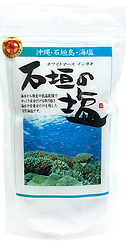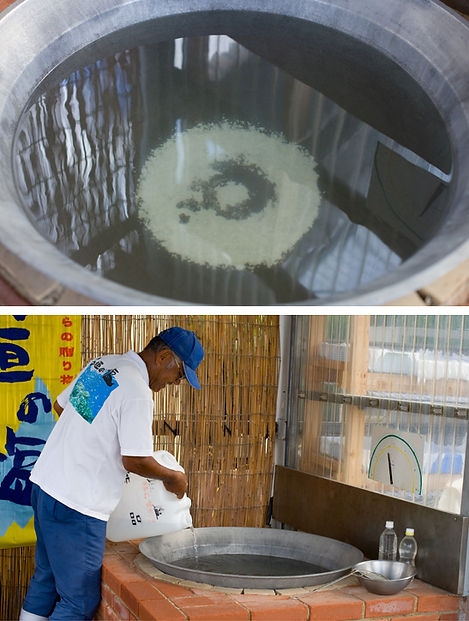
Human and Nature Friendly
Delicious relationhip between
Salt of Ishigaki and Yaeyama Island
Ingrediends are only "rich forest and ocean".
What more can we do?
Salt making in
Ishigaki Island
In the island dialect, Nagura Bay means "a place where fry gather".
This ocean is so rich that
the locals come here to pick up food for their evening meal.
"What we try to do is to keep in step with nature as much as possible."
In other words, we try to ask for a little help to nature as it is.
"The seawater of Nagura Bay is full of life,
and that is the starting point of our salt production."
#04


the nature of the Yaeyama Islands does. "
"We do not make salt,
instead,
Our craftsmen look out upon the sea and say with confidence,
"Salt is created by the wisdom of the ancient craftsmen,
as if they were gently gathering their hands together on Mother Nature."

Coral Reefs
By looking at the coral reefs, you can easily tell if the ocean is healthy or not.
The picture of coral reefs on the package of Salt of Ishigaki tells us the health of the ocean at the intake point of the saltwater.


#04
First, take up
the seawater from Nagura Bay
How to create
Salt of Ishigaki?

The traditional old ways are passed down as they are, and modern technology is used to the extent that it does not burden nature.
The Salt of Ishigaki is the result of a wonderful docking of the past and present.
We are very environmentally conscious. We have won the Monodzukuri Grand Award, which shows that it is endorsed by the Ministry of Economy, Trade and Industry (METI) and the Japan Patent Office.


On the beach behind the workshop, eyes will flicker at the hermit carbs playing innocently.
There is a thin pipe, laid toward the west, which is the direction of the sunset.
This pipe is the intake pipe essential for our salt making, which is sunk into the ocean, and extend far out into the offshore in the shape of a "ku(く)" partially. This place where seawater is pumped up is Nagura Bay, which is the wide shallow ocean with a variety of ecosystems such as seaweed beds and coral reefs.
There are many corals in the ocean, so we first run the pipes avoiding the corals so as not to disturb them.
After a typhoon, the pipes always come loose, so each time we have to "redo" the work again by hand from scratch.
#04
Day 1: Boiling
Seawater in a Pot
There are several methods of salt production, including "Sun-dried salt" and "Jigama(pot)-cooking salt". Sun-dried salt is produced by evaporating water in the sun using salt fields. In contrast, pot-cooking salt is produced by boiling salt in a pot to crystallize the salt.
There are many ways to make Salt of Ishigaki, but this time, we will take a look into the Jigama (pot)-cooking method.
First, seawater taken from 1.5km offshore, and the impurities such as algae are filtered out and stored in a tank.
Then, the filtered seawater is transferred to a small polyethylene tank, and Ojii, the craftsman in charge, poured it into a huge pot, which can be estimated about one meter in diameter.
When the pot is almost eight parts full, the lid is put on and the fire is ignited. Here is the beginning of the long and patient process.

It's just a salt, but it's still a SALT.
It takes three days to boil down.
Today, with technological innovation, mass production is possible. So you might be wondered if we were using large machines, but you will find out soon that we are not using any of them......
Instead, the process starts with boiling in a large pod. Furthermore, when drying them in the sun, it usually takes three days in summer and a month in winter.
#04
Even SALT breathes with
the deliberate island time.

Day Two:
Boil it Down even Slower

Day two! We open the lid of the heavy pot and check the condition inside. ...... It's time for a few white crystals to form on the surface.
Next to the pot slowly and deliberately boiling down, Ojii said, "This is the 'egg-like' state of the salt." As if time has stopped, the lid snaps shut again.....
With the island wind caressing our cheeks, time passes slowly on the second day.
The largest butterfly in Japan, Oogomadara, flies through the greenery in a rustling sound.
#04
Day Three: Carefully.
Again and Again.
"Well..." said Ojii. When we open the lid, steam with a slight sweet taste spread all around.
"Oh, it's done! It's done!" As Ojii stirred the pot, many beautiful crystals are caught on the net. We take a finger and licked it, then the taste could be a side dish in it self, spread in the mouth. Ojii keep scooping the salt. Crunch, crunch. Crunch, crunch......

After that, the craftsmen of Salt of Ishigaki carefully find and remove impurities by hand, which are completely unnoticeable to the ordinary eye.
Workshop head (voice): "In the end, no matter how much we try to mechanize the process, it is still human hands that we rely on in the end. Not only can't machines sort out the seaweed that is mixed in with the seawater, they break down because of that (laughs)."
In the end, after trying many different methods, we arrives at a simple path.

Ojii also carefully crushes the dried salt with a mallet, little by little, according to the customer's request.
#04
To Even More Special Salts.

Normally, salt crystals are extracted by steaming seawater in a "multi-stage evaporating dish" consisting of three layers of flat pots, and the product is a slightly moistened, low-temperature dried salt. This is the most popular product of Salt of Ishigaki.
Although, there is also a salt that is made by further processing called, "baked salt," a higher grade of salt. After a few hours of roasting in a baking oven, a salt as smooth as powder is produced. Everyone who purchase this salt told us that this salt fit easily into Japanese cuisine.
After the water is evaporated and crystallized to a certain extent in a pot, the salt is slowly exposed to the sun in a plastic greenhouse, where temperatures can reach 70°C or higher during the summer.
The salt is made in a few days in the summer when the sun is strong, but in the winter when the weather is cloudy, it may take more than a month to complete.
Many fans of this special salt cannot stop eating it once they have had it. The taste is different from that of low-temperature dried salt because the bittern is removed differently.
#04
Let's be True to Nature
Seawater has no place to go to waste. "Then what about the seawater after the salt is removed?" That is bittern. It is used as a coagulant for tofu and for pest control.
Because it is full of nutrients from the sea, bittern is heavier than water of the same volume. We hold the plastic bottle Ojii hands to us and feel a big thud. "Wow, how strange!"
When we look into the pot, we saw that the seawater have just begun to simmer before it was separated into bittern and salt.

No matter how we change the shape of nature, it always tries to return to its original form. Everytime after the typhoon hit, we all go to fix the intake pipes and find that octopuses and moray eels are trying to live in the pipes. It is very hard for us to fix them from scratch again.
Even though, don't you think that is a healthy state of the ocean? We are using seawater that is coraboratinwith marine life and table corals that are as healthy as young men. Our salt is made from the seawater, which nurture prenty of life, without adding or subtract anything artificial. It is just a gift from the ocean.
Today, under a blue sky, with a single airplane cloud, smiling quietly in the green of the beach, we continue to make Salt of Ishigaki, a salt that is friendly to both human and nature.
